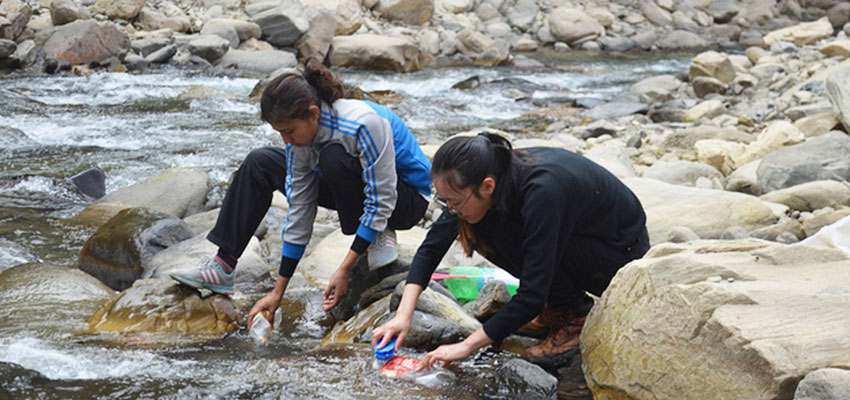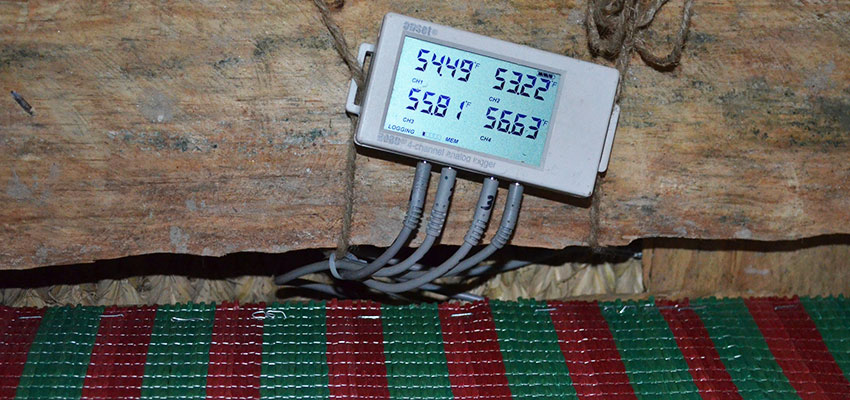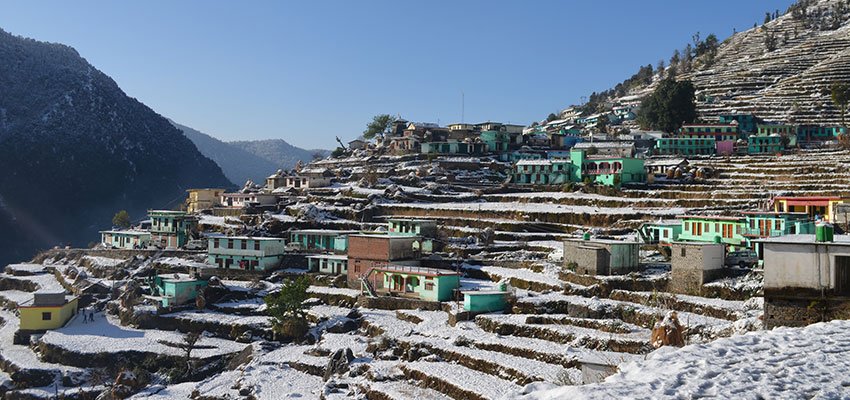
Building off a 2018 D-Lab energy needs assessment
Last year, in January of 2018, a group of students from the MIT D-Lab: Development class conducted an energy needs assessment in the rural village of Solambu, Nepal. In collaboration with the Kathmandu University (KU) in Dhulikhel, Nepal and the People’s Scientific Institute in Dehradun, India, they set out with the goal of providing a framework to identify opportunities where increased access to improved energy-related products and technologies can benefit communities. Over the next two semesters, the D-Lab Energy Research group along with the team from KU and PSI worked together in analysing data and identified improved indoor thermal comfort as an energy challenge to work on in Himalayan Homes.
Installing insulation to test a hypotheses
With input from the local community in Nepal and India, the team was made aware of low-cost locally available material such as chatai, scrap plastic bottles, straw, and pine cones available at both locations in India and Nepal. Given this knowledge, the D-Lab students conducted lab tests in Fall 2018 in MIT’s Building Technology Group (BTG) with the assistance of Professor Leon Glicksman and Jonathan Kongoletos, a PhD student in BTG. The tests pointed the group towards a design with 4 cm of scrap plastic or straw sandwiched between two layers of chatai produced values of thermal resistance equal to R5 foam board insulation available in the US at Home Depot or Lowe’s.
This year, during MIT’s Independent Activities Period (IAP), a new group of MIT D-Lab students went to India with the aim of installing insulation in a room in Solambu, Nepal and Ransi, India to test the effectiveness of the low-cost insulation panels made at MIT using temperature sensors made by Sensen (a start up at D-lab) and an Onset HOBO. The MIT group was led by D-Lab Postdoctoral Researcher Anish Paul Antony and included three MIT undergraduate students (Ting Li, Jackie Lin, John Michael Reyes), one MIT graduate student (Ines Sanz Morère), and one Harvard graduate student (Djénéba Gory). The KU team was led again by Shailendra Jha (Assistant Professor in Electrical and Electronics Engineering, KU) along with one master’s student (Bhuwan Paudel) and three KU undergraduates from Electrical and Electronics Engineering (Shanta Aryal, Sandhya Bohara, and Prashant Tiwari).
We spent the first day with the KU team in Dhulikhel, getting a better sense of the project and the materials we would need to gather to execute on the project. We collected three large sacks of scrap water bottles (around 15 kg per bag) from Banepa, Nepal along with the chatai and the sukul for the roof.
Solambu, Nepal
We arrived in Solambu on the afternoon of January 14th, after a strenuous four-hour ride through bumpy dirt roads.

The first day, the entire team went down to the river to wash and scrub the bottles, after which, we started to sew two chatai mats with scrap plastic sandwiched in between. This formed a panel of insulation that was 4 feet wide by 5 feet in length. Each panel had 20 sewn pockets, each of which held two empty plastic bottles. The panels took around two to three hourse each to make. We ended up making 13 full-size panels and six to eight smaller panels after measuring the room (18 feet x 10 feet x 8 feet) and accounting for the uneven measurements between the windows and walls. Some of these panels were stuffed with straw as this was locally available in the village and showed similar results to the plastic bottles in lab tests conducted back at MIT.

The panels with straw were carefully placed closer to the roof on the side walls. This was done taking into account feedback we received from the community in Ransi where they mentioned that rats have a tendency to burrow through the straw and usually move from the ground upwards. This having scrap plastic filled insulation in the bottom layer and straw filled insulation in the top layer we hope to avoid the rat problem. For the ceiling, we used 10 sukul mats again obtained locally in Nepal. Installation itself took five people two days to complete.

Finally, we set up a temperature sensor (with four4 probes) to collect data on temperatures inside and outside the insulated room. Additionally during our time in Nepal Anish also set up Sensen HAP’s to measure indoor and outdoor air quality in Solambu. We are currently waiting for calibration curves from Sensen to make the air quality data public.


Ransi, India

When we arrived in Dehradun, the nearest major city to Ransi, there were thunderstorms and rain in the entire region. This impacted our plans to source hay from Ransi because the hay would be wet. Wet hay sewn into chatai mats would potentially mold and pose a health hazard to those in the home. It was also difficult to source plastic water bottles because there was no water bottle collecting program. Instead, we bought thirty 4 foot x 6 foot foam sheets from a foam and upholstery store in Dehradun. We were able to find chatai in the local market and bought that. We arrived in Ransi at night on Jan 23 after a 12-hour drive. We found snow in Ransi.

The first day, we took the dimensions of the room and by afternoon, we completed the insulation panels and installed them in the home. We made nine full panels, and installed foam sheets to the ceiling. This process was much faster than Solambu because the room we insulated was smaller and we were experts in making the insulation panels at this point based on our experience in Nepal. The next day, a sensen temperature sensor was installed to take readings from the exterior of the building, the interior between the wall and the insulation, on the insulation, and the center of the insulated room.

After completing the insulation of both homes, the homeowners seemed very enthusiastic about the results. Particularly, in Solambu, we found during interviews that many other villagers were interested in having the insulation in their own homes. Sewing the chatai mats themselves — including inserting plastic water bottles and sewing 20 pockets per mat — were very labor intensive.

But we do foresee efficiency in the future if this can be turned into a local business using simple machinery. For now, we plan on collecting data from both homes for a year and analyzing the effectiveness, as well as getting feedback from the villagers. If results are deemed significant, we plan on running a design workshop next January in either one or both villages to teach the villagers the benefits of our insulation methods and also how to make and install it in their own homes. Finally, in the long run, we hope that this insulation project will be adopted widely in surrounding villages. It could also be turned into informal businesses for villagers, particularly women, hopefully serving to mitigate the gender gap apparent in the village.


